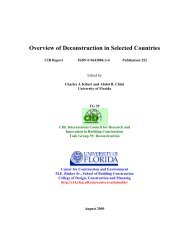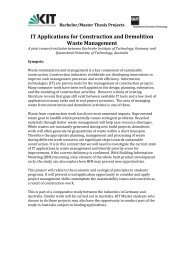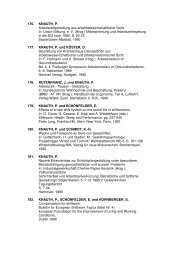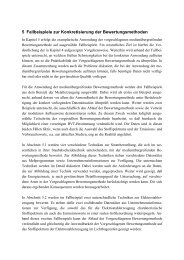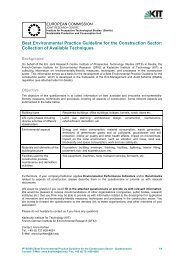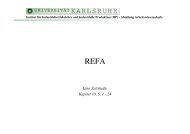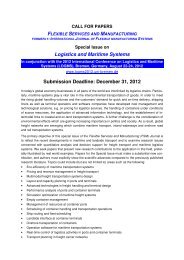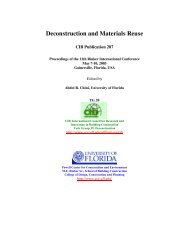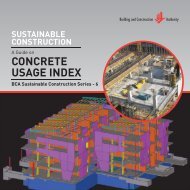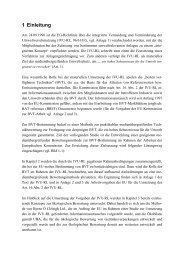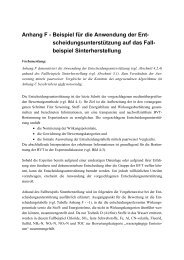Waste reduction final report -4 - Test Input
Waste reduction final report -4 - Test Input
Waste reduction final report -4 - Test Input
Create successful ePaper yourself
Turn your PDF publications into a flip-book with our unique Google optimized e-Paper software.
study mentioned before claims that there have to be a certain amount of material illegally<br />
dumped or backfilled. It says that this can be supposed as a result of mass balances.<br />
Some of the waste materials are discussed in the following parts. On the one side, these are<br />
important materials in view of needed amounts, furthermore there are presented materials<br />
with a great potential for recycling in future and <strong>final</strong>ly, the discussion will be hold on an<br />
exemplary case for a material not mentioned until now in this <strong>report</strong>.<br />
Concrete<br />
Concrete is a mixture of aggregate (gravel), water, cement, additives and other chemical<br />
admixtures. The definition of recycling concrete as to SN EN 206-1 (2000) includes a<br />
minimum of 25 % in weight of recycled concrete aggregates and/or recycled mixed<br />
aggregates [SNV 2000]. Secondary concrete can therefore be made out of concrete<br />
demolition, mixed mineral debris or asphalt. In Switzerland, recycled asphalt conrete and<br />
concrete made of concrete are widely accepted. In contrast, secondary material out of mixed<br />
C&D waste still does not have a good reputation on the market due to strongly unsteady<br />
properties (see section below). Another issue is that life cycle assessments (LCA’s) have<br />
shown the secondary concrete does not improve environmental impacts (especially for CO 2<br />
emissions) much if at all, so that this incentive drops out for companies (“greener”<br />
products/production). The crucial points for CO 2 emissions in (recycling) concrete production<br />
are the type and amount of cement. Furthermore, type and distance of transport have a big<br />
influence on environmental performance [Kytzia 2009, TUM 2006]. A positive result of<br />
those LCA’s proves the durability of recycling concrete to be as high as of primary material.<br />
Furthermore, the use of waste as resource helps to protect valuable soil resources.<br />
On the economic side, the price for recycling concrete is equal or higher than the one for<br />
primary concrete. However, on the long term, secondary materials could become cheaper<br />
than primary materials, depending on technologies and fees for waste conditioning or<br />
landfilling. All in all, [Dosho 2008] concludes that encouragement of the use of recycled<br />
aggregate concrete needs to secure a good balance between (a) safety and quality, (b)<br />
environmental impact, and (c) cost effectiveness.<br />
Recycled mixed aggregates<br />
As a special case of concrete raw material, recycled mixed aggregates are presented in this<br />
section. Recycled mixed aggregates can be made out of bricking and/or out of mixed mineral<br />
materials. As long as materials can’t be separated in a proper way, recycled mixed aggregates<br />
would ostensibly be a very good solution to prevent landfilling. However, only estimated<br />
20% of bricking and mixed mineral waste is recycled. Even if there are other unrecorded<br />
uses, a big amount of these materials is still landfilled.<br />
Recycled mixed aggregates are not well accepted in the industry because of several properties<br />
listed below [Hoffmann 2005]:<br />
- Gypsum, fine materials or other materials are not desirable in recycled mixed aggregates,<br />
but today can’t be avoided in many cases.<br />
- Composition of the granules fluctuates much and therefore the properties of the material.<br />
- Because of a high amount of non-cubic aggregates, cavity is higher and therefore the<br />
need of cement increases. The same is valid for water absorption.<br />
- The more mixed mineral debris, the lower is the modulus of elasticity. As compressive<br />
resistance remains the same, a higher distortion results.<br />
- Shrinking is twice as high as for primary gravel.<br />
103



